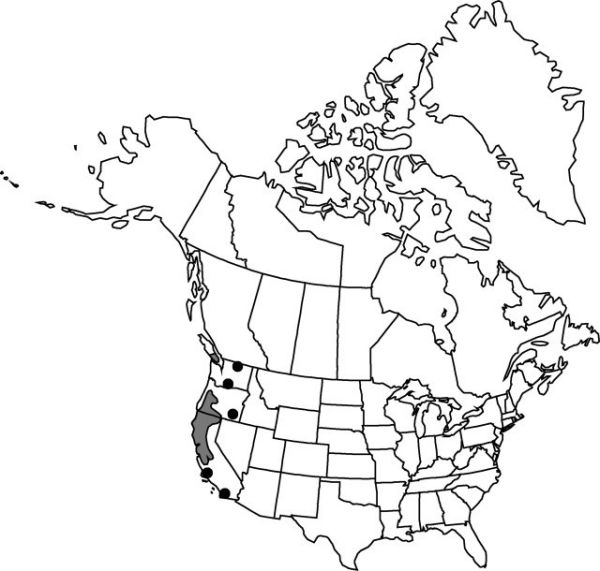Difference between revisions of "Allium ampeloprasum"
Sp. Pl. 1: 294. 1753.
FNA>Volume Importer |
imported>Volume Importer |
||
| (3 intermediate revisions by 2 users not shown) | |||
| Line 8: | Line 8: | ||
}} | }} | ||
|common_names=Wild leek | |common_names=Wild leek | ||
| + | |special_status={{Treatment/ID/Special_status | ||
| + | |code=I | ||
| + | |label=Introduced | ||
| + | }} | ||
|basionyms= | |basionyms= | ||
|synonyms= | |synonyms= | ||
| Line 24: | Line 28: | ||
|elevation=0–100 m | |elevation=0–100 m | ||
|distribution=Europe;Asia;n Africa. | |distribution=Europe;Asia;n Africa. | ||
| + | |introduced=true | ||
|discussion=<p>Normally the umbel of <i>Allium ampeloprasum</i> has no bulbils, but there are some variants with a few flowers that produce bulbils. The species has been reported as established in New England and adjacent Canada and can be found along roadsides and in other disturbed areas. It is probably conspecific with A. porrum Linnaeus, the leek of commerce. <i>Allium</i> porrum can be distinguished from <i>A. ampeloprasum</i> based on its unique bulb morphology and chemistry from centuries of cultivation and selection.</p> | |discussion=<p>Normally the umbel of <i>Allium ampeloprasum</i> has no bulbils, but there are some variants with a few flowers that produce bulbils. The species has been reported as established in New England and adjacent Canada and can be found along roadsides and in other disturbed areas. It is probably conspecific with A. porrum Linnaeus, the leek of commerce. <i>Allium</i> porrum can be distinguished from <i>A. ampeloprasum</i> based on its unique bulb morphology and chemistry from centuries of cultivation and selection.</p> | ||
|tables= | |tables= | ||
| Line 33: | Line 38: | ||
-->{{#Taxon: | -->{{#Taxon: | ||
name=Allium ampeloprasum | name=Allium ampeloprasum | ||
| − | |||
|authority=Linnaeus | |authority=Linnaeus | ||
|rank=species | |rank=species | ||
| Line 48: | Line 52: | ||
|publication title=Sp. Pl. | |publication title=Sp. Pl. | ||
|publication year=1753 | |publication year=1753 | ||
| − | |special status= | + | |special status=Introduced |
| − | |source xml=https:// | + | |source xml=https://bitbucket.org/aafc-mbb/fna-data-curation/src/2e0870ddd59836b60bcf96646a41e87ea5a5943a/coarse_grained_fna_xml/V26/V26_412.xml |
|genus=Allium | |genus=Allium | ||
|species=Allium ampeloprasum | |species=Allium ampeloprasum | ||
Latest revision as of 21:15, 5 November 2020
Bulbs 1–3+, variable, some with poorly developed bulbs, others ovoid with 1–2 large bulbs and several yellowish to light brown bulbels at base, 0.4–1(–3) × 0.4–1(–1.5) cm; outer coat enclosing 1 or more bulbs, yellowish, membranous; inner coats white to light brown, cells not evident, fibers ± parallel, few. Leaves withering from tips by anthesis, 6–9, sheathing 1/3–1/2 scape; blade solid, flat, channeled, 1–5 cm × 2–20(–30) mm, margins scabrid. Scape persistent, solitary, erect, fistulose, terete, 45–180 cm × 3–7 mm. Umbel persistent, erect, compact, to 500-flowered, few-flowered in variants with bulbils, globose; spathe bracts persistent, 3–5, 2–3-veined, lanceolate, ± equal, apex abruptly narrowed to beak, beak to 10 cm. Flowers urceolate, 4–5.5 mm; tepals erect, white, pink, or dark red, unequal, becoming papery and investing capsule in fruit; outer tepal oblong-lanceolate, margins entire, apex obtuse, sometimes mucronate; inner tepal narrowly ovate to spatulate, margins entire, apex obtuse; stamens equaling perianth or exserted; outer filaments simple, inner with 2 prominent lateral teeth that exceed anther-bearing portion, glabrous; anthers yellow or purple; pollen yellow; ovary crestless; style linear, equaling stamens; stigma capitate, scarcely thickened, unlobed; pedicel 15–50 mm. Seed coat not known.
Phenology: Flowering Apr–Jul.
Habitat: Roadsides and other disturbed areas
Elevation: 0–100 m
Distribution

Introduced; Europe, Asia, n Africa.
Discussion
Normally the umbel of Allium ampeloprasum has no bulbils, but there are some variants with a few flowers that produce bulbils. The species has been reported as established in New England and adjacent Canada and can be found along roadsides and in other disturbed areas. It is probably conspecific with A. porrum Linnaeus, the leek of commerce. Allium porrum can be distinguished from A. ampeloprasum based on its unique bulb morphology and chemistry from centuries of cultivation and selection.
Selected References
None.